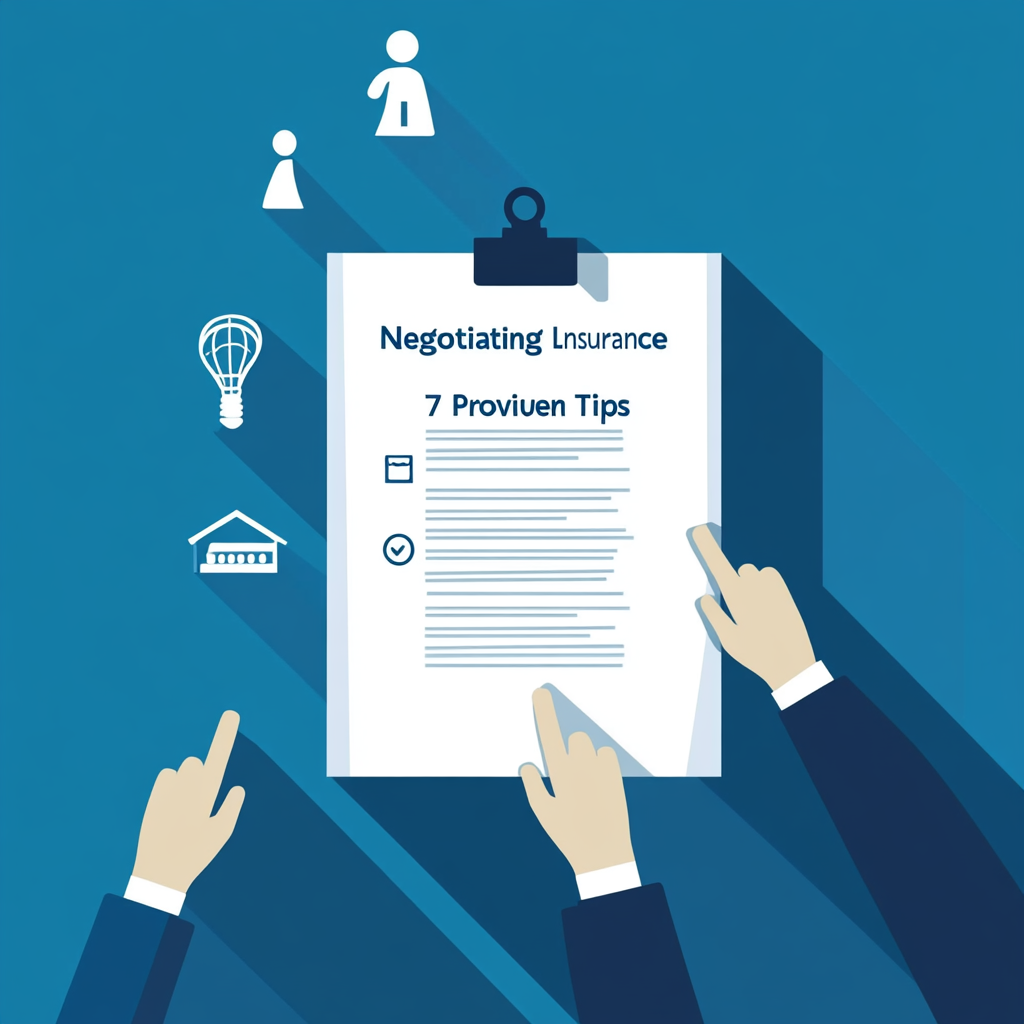1. Introduction
Many people accept insurance premiums as non-negotiable fixed costs, but the reality is carriers build considerable flexibility into renewal pricing and loyalty incentives. Negotiating Lower Insurance Premiums involves understanding how companies calculate risk, presenting yourself as a low-risk customer, and timing your discussions to coincide with retention windows when insurers are most motivated to keep existing clients. In this guide, you’ll discover seven proven tips—from bundling and risk-profile improvements to agent relationship building and professional discounts—each illustrated with real-world examples and step-by-step tactics. Whether you want to save on auto, home, renters, or life insurance, these strategies will empower you to reduce your premiums by 10–30% annually without sacrificing coverage. For foundational guidance on selecting the right policy features, see our internal article Insider Tips: Choosing the Right Insurance.
2. Understanding Insurance Premiums
Insurance premiums reflect a carrier’s forecast of your expected claim costs plus administrative expenses and profit margins. To negotiate effectively, you must know which factors underwriters weigh most heavily and how those translate into dollars.
2.1 Demographic and Lifestyle Factors
Underwriters consider age, gender, marital status, and occupation. Younger drivers typically pay higher auto premiums due to statistically higher accident rates. Single homeowners may face higher home insurance rates than married couples, as data links marriage with greater property maintenance and stability. Occupation influences life and disability insurance; hazardous professions or frequent business travel can increase rates substantially.
2.2 Geographic and Property Characteristics
Location-based risk models analyze ZIP-code crime rates, local weather hazards (flood, tornado, earthquake), and construction costs. Coastal homeowners pay more for wind-storm coverage, while urban auto owners face higher theft and vandalism rates. Property features—roof type, age of wiring, presence of fire sprinklers—can trigger discounts or surcharges. Recognizing these local and structural variables helps you negotiate coverage based on precise risk factors rather than blanket assumptions.
2.3 Credit and Claims History
Many insurers employ credit-based insurance scores, correlating lower credit delinquency with fewer claims. A 20-point score improvement can yield a 5–10% premium reduction. Claims history drives surcharges: a single at-fault accident can boost auto premiums 20–40% for three years, while a homeowner’s water-damage claim may add 15–25%. By avoiding minor claims—paying small losses out-of-pocket—you maintain a clean record, which becomes key leverage when you ask for lower rates.
3. Tip 1: Bundle Policies for Multi-Policy Discounts
3.1 Mechanics of Bundling
Bundling works because insurers recognize the lower per-policy administrative and acquisition costs when one household buys multiple products. By placing your auto, homeowners, and umbrella policies with the same carrier, you signal loyalty and convenience—factors the company rewards with discounts typically ranging from 10–25% per policy. Insurers calculate their “cost to serve” per policy, which drops significantly when they issue multiple lines under a single account. These savings are passed back to you as multi-policy credits.
Moreover, bundling simplifies claims coordination. If you experience a natural disaster, the carrier can manage both your auto and home claims in tandem, reducing overhead and accelerating processing. That efficiency benefit translates directly into a willingness to offer steeper discounts up front. Always ask your agent not only for a bundled premium but also for the percentage breakdown per line, so you know exactly how much you’re saving on each policy.
Finally, bundling can protect you from rate hikes. If one line sees a significant market increase (for example, homeowners due to hurricane damage in your area), the bundled structure can soften the blow on your overall cost, as the carrier balances rates across product lines to maintain retention.
3.2 Real-World Savings Example
Consider the Johnson family, whose separate annual premiums were $1,200 for auto and $1,800 for home—a total of $3,000. By bundling both lines under Carrier Z, they unlocked a 20% discount on each policy. Their new combined premium became $2,400, saving $600 in year one. Over a five-year term, assuming steady rates, that amounts to $3,000 saved—enough to pay for a family vacation or bolster their emergency fund.
Case studies like this illustrate the compounding effect of bundling. Even if a single-line discount seems modest, the multi-year impact can be significant. When you present such examples to your agent—“My neighbor the Johnsons saved 20% last year by bundling; can I get the same?”—you create social proof that encourages the carrier to apply the same treatment to your account.
3.3 How to Request a Bundled Quote
First, gather your current declarations pages for each policy, noting coverage limits, deductibles, and riders. Next, contact your agent or log into your carrier’s portal and request separate renewal quotes for each line as a baseline. Then ask explicitly: “If I bundle both policies, what discount can you apply?” Provide your baseline numbers to back up the request. If the agent hesitates, mention competing bundled quotes you’ve obtained independently—carrier names and premium figures.

Once you receive the bundled quote, carefully compare it to your standalone renewals. Confirm that coverage limits, deductibles, and exclusions remain exactly the same. Ask for written confirmation—either email or portal documentation—of the discount percentage and new premium. Finally, set a calendar reminder for six months before renewal to re-evaluate your bundling opportunity, as market changes can affect discount levels over time.
4. Tip 2: Improve Your Risk Profile
4.1 Boosting Your Credit Score
Credit-based insurance scores play a major role in determining your premiums. These scores differ slightly from standard FICO credit scores but rely on many of the same data points: payment history, credit utilization, length of credit history, and new account inquiries. Start by pulling your credit report from the three major bureaus (Experian, TransUnion, Equifax) to identify any errors—incorrect accounts or outdated collections—that might drag down your score. Dispute inaccuracies promptly to raise your score by 10–20 points within 30–60 days.
Next, tackle revolving balances. Your credit utilization ratio—the percentage of available credit you’re using—is a key driver. Aim to keep utilization below 30%, and ideally under 10%, by paying down credit-card balances or asking for credit limit increases. Consistently pay all bills on time; even one late payment can cost you points. As your credit-based insurance score rises, contact your carrier’s underwriting department to request a policy re-rating. Many insurers will apply improved scores to your renewal premium without requiring a formal negotiation.
4.2 Avoiding Minor Claims That Spike Rates
Filing small claims for modest damages—like a $400 windshield crack or a $900 water leak—can trigger rate increases of 15–30%. To avoid this, establish a dedicated repair fund within your emergency savings to cover out-of-pocket expenses that fall below your deductible. This approach preserves your no-claim discounts and maintains your position in the lowest risk tier.
Track repair costs and fund allocations to quantify your savings. For example, if your auto deductible is $500 and you cover a $450 repair yourself, you forgo a claim that might have raised your annual premium by $150. Over three years, that decision saves you $450, far outweighing the immediate repair cost. Present these numbers to your agent when negotiating, showcasing that your actions keep risk—and claims—low.
4.3 Installing Safety and Security Features
Upgrading your home with monitored security systems, smoke and carbon-monoxide detectors, or reinforced entry points not only protects your property but also qualifies you for immediate insurer discounts of 5–15%. Collect installation receipts and certification letters from your vendor, and forward them to your agent or upload them to your insurer’s portal.
Similarly, adding vehicle anti-theft technologies—GPS trackers, immobilizers, alarm systems—earns reductions in your auto premium. Some insurers even partner with third-party telematics providers: installing a device in your car that tracks driving habits (speed, braking, mileage) can yield further usage-based discounts up to 25%. These programs reward safe driving with lower rates, so enroll and maintain good driving behavior to maximize savings.
5. Tip 3: Shop Around and Compare Quotes
5.1 Utilizing Aggregator Platforms
Aggregator platforms like Policygenius streamline the initial quote-gathering process, allowing you to compare multiple life, auto, and home insurance estimates in one place. Begin by entering precise personal information—age, marital status, credit range—and detailed property data—home square footage, year built, construction type. Aggregators generate baseline term life quotes alongside auto and home estimates, giving you a quick market snapshot.
However, treat aggregator quotes as starting points. Carriers often adjust rates based on proprietary risk models and underwriting criteria that aren’t fully captured in third-party tools. Use the quotes to identify carriers worth pursuing, then contact them directly (via online portal or phone) to get official quotes from their in-house underwriting system, ensuring accuracy and capturing any sponsor-only or members-only discounts.
5.2 Partnering with Independent Agents
Independent agents represent multiple carriers without allegiance to any one company. Provide your policy details and ask them to solicit quotes across their network. Independent agents excel at uncovering niche underwriters and regional carriers that may offer superior rates for your specific profile. Ask the agent to document each quote’s breakdown—base premium, fees, discounts, surcharge factors—so you can perform an apples-to-apples comparison.
Moreover, independent agents often have insights into upcoming underwriting changes or promotional discount periods that you can leverage immediately. They can advise when to lock in a rate or wait for a known down-cycle in premiums. Build a cooperative relationship: share your negotiation goals and let the agent provide regular market updates between renewal cycles.
5.3 Standardizing Comparison Metrics
To ensure fair comparisons, create a spreadsheet listing each quote’s key variables: coverage limits (liability, collision, comprehensive), deductibles, endorsements (rental reimbursement, flood), policy fees, and effective dates. Assign each carrier a scorecard, weighting factors by your personal priorities—lowest premium, broadest coverage, or most discounts. This structured approach removes ambiguity and emotionally driven choices, focusing your negotiations on concrete data.
When negotiating with your incumbent carrier, reference the lowest competitor quote: “Carrier Y offers $1,000 for identical coverage. Can you match or beat that?” Having a scorecard demonstrates preparation and credibility, making insurers more inclined to offer competitive concessions.

6. Tip 4: Leverage Renewal-Time Negotiations
6.1 Accessing Retention and Loyalty Departments
Renewals are when insurers allocate most retention budgets. Instead of speaking with a general customer-service representative, request a transfer to the retention or loyalty department, whose mandate is to retain existing policyholders. Retention teams often have discretionary authority to apply unadvertised discounts, extra credits, or cover small surcharges.
6.2 Crafting a Data-Driven Negotiation Script
Preparation is key. Compile your best competitor quotes, current policy details, and desired discount percentage. A sample script:
“I’ve appreciated your service for five years, but I’ve received an auto + home bundled quote of $2,200 elsewhere versus my renewal offer of $2,600. What can you do to match or beat that blended rate?”
Including exact numbers shows you’re serious and have done your homework.
6.3 Timing Your Renewal Negotiation
Initiate the discussion 45–60 days before your renewal date. This timeframe allows back-and-forth adjustments, gives you time to evaluate multiple offers, and ensures coverage doesn’t lapse. Insurers are more flexible earlier in the cycle—waiting until the final two weeks can limit your leverage as their retention budgets dry up.
7. Tip 5: Increase Deductibles Strategically
7.1 Quantifying Deductible Impact
Increasing your auto collision deductible from $500 to $1,000 can cut premiums by 15–25%, depending on your profile and insurer. Similarly, raising homeowners’ deductibles from $1,000 to $2,500 often yields 10–20% reductions. Calculate your savings: on a $1,200 auto premium, a 20% cut saves $240, equating to an additional $6,000 you can allocate over 25 years.
7.2 Emergency Fund Capacity Planning
Before adjusting, stress-test your emergency fund. Simulate plausible scenarios: a cracked windshield, a minor fender bender, or a small flood repair. Aggregate these potential costs—$500 + $1,500 + $2,000—and ensure your savings can absorb them without resorting to high-interest debt.
7.3 Long-Term Strategy and Review
Use a simple spreadsheet to project five- and ten-year savings versus expected out-of-pocket costs. Factor in claim frequency probabilities from your insurer’s experience tables or public actuarial reports. Revisit this model annually—if claim rates spike or repair costs rise, adjust deductibles and premiums accordingly.

8. Tip 6: Negotiate Directly with Your Agent
8.1 Cultivating a Partnership
Agents are more inclined to help policyholders who maintain open communication. Share upcoming life changes—college-age children, rental property acquisitions, part-time business ventures—and ask how these affect your rates. Agents use this information to re-underwrite your profile and may uncover additional savings.
8.2 Discovering Unadvertised Discounts
Frequently, carriers offer “agent-only” discounts—codes or programs that aren’t public. Ask directly: “Are there any renewal loyalty, tenure, or professional affiliation codes I can utilize?” Agents often have internal memos detailing these programs.
8.3 Ensuring Accurate Application
After negotiations, request written confirmation of any agreed-upon discounts, credits, or re-rated premiums. Check your renewal invoice or policy documents to confirm terms before the payment due date. Dispute any discrepancies immediately to avoid paying higher rates inadvertently.
9. Tip 7: Leverage Affiliation and Professional Discounts
9.1 Employer-Sponsored Programs
Employers frequently negotiate group insurance rates on behalf of employees, even for personal lines. Check your company’s HR or benefits portal for carrier endorsements and discount codes. Present these codes during negotiation to layer additional savings.
9.2 Association and Alumni Benefits
Memberships in organizations like AARP, veterans’ groups, or university alumni networks come with negotiated insurance rates. Access member-only web pages or present membership IDs to your agent for policy adjustments.
9.3 Compound Stacking
Combine employer, association, and loyalty discounts for maximum effect. For example, a 10% employer discount + 5% alumni discount + 10% multi-policy discount yields a total of 25% off baseline rates. Always verify stacking rules with your carrier—some discounts cannot be combined.
10. Common Pitfalls to Avoid
Even the most diligent negotiators can stumble into traps that erode savings or leave them underinsured. One frequent mistake is accepting the first quote without gathering alternatives. Carriers know many customers won’t shop again once they see a renewal offer, so initial rates are often inflated. Always obtain at least three competing quotes and verify they match your exact coverage needs before committing.
Another pitfall is overreliance on small claims. Filing a claim for minor damage—say a $500 windshield chip or a $900 roof leak—may seem sensible, but these “small” claims often trigger significant surcharges that cost far more over time than paying out-of-pocket. Preserve your no-claim discounts by maintaining a dedicated repair fund for losses below your deductible.
A third error is failing to document negotiated changes. Verbal promises of discounts or policy adjustments can vanish if not recorded. After every negotiation call or email, request written confirmation of revised premiums, new deductibles, and any added credits. Compare your renewal invoice line by line against that confirmation to ensure accuracy; contest any discrepancies immediately.
Finally, many policyholders miss mid-term review opportunities. Life changes—like improved credit scores, added security systems, or updated home renovations—often qualify you for immediate re-rating outside the normal renewal window. Stay proactive: set calendar reminders to revisit your profile quarterly and ask your agent to re-evaluate your rates.
For a concise visual recap of these pitfalls and expert advice on avoiding them, watch the YouTube tutorial “How to Negotiate Insurance Rates”, which outlines each common mistake and provides step-by-step strategies to keep your premiums as low as possible.
11.Conclusion
Mastering Negotiating Lower Insurance Premiums transforms your approach to insurance from reactive to proactive, empowering you to take control of one of your largest recurring expenses. By applying the seven proven strategies—bundling multiple policies, enhancing your risk profile, rigorously comparing quotes, leveraging renewal-time negotiations, strategically increasing deductibles, partnering closely with your agent, and stacking professional affiliation discounts—you build a dynamic framework that adapts to life changes and market shifts. Commit to annual policy reviews, document every negotiation, and track your savings to ensure ongoing success. With Negotiating Lower Insurance Premiums as a core skill, you’ll consistently reduce your premiums by 10–30%, freeing up capital for investments, debt repayment, or bolstering your emergency fund, and securing greater financial peace of mind.
Navigating credit cards and insurance can feel overwhelming. This digital bundle gives you insider tips on choosing the best cards for rewards, boosting your credit score fast, and picking insurance plans that actually protect what matters—without breaking the bank.
Grab your bundle now.
12. Frequently Asked Questions (FAQ)
Q1: How much can I save?
You can typically save 10–30% per policy, equating to $300–$900 on a $3,000 annual premium.
Q2: When should I negotiate?
Start 30–60 days before renewal; mid-term reviews can follow major life events.
Q3: Will my coverage change?
No—if you maintain identical terms; always verify updated policy documents.
Q4: Do all insurers negotiate?
Most national carriers have retention desks; flexibility varies. Independent agents can identify the most flexible companies.
Q5: Can I automate the process?
Platforms like Policygenius offer alerts and automated quote comparisons, but personal agent engagement remains crucial for hidden discounts.



